
What travel vaccines do I need?
What Travel Vaccines Do I Need as a Canadian Traveler? Traveling is life’s greatest joys! However, exploring the world can sometimes expose you to health
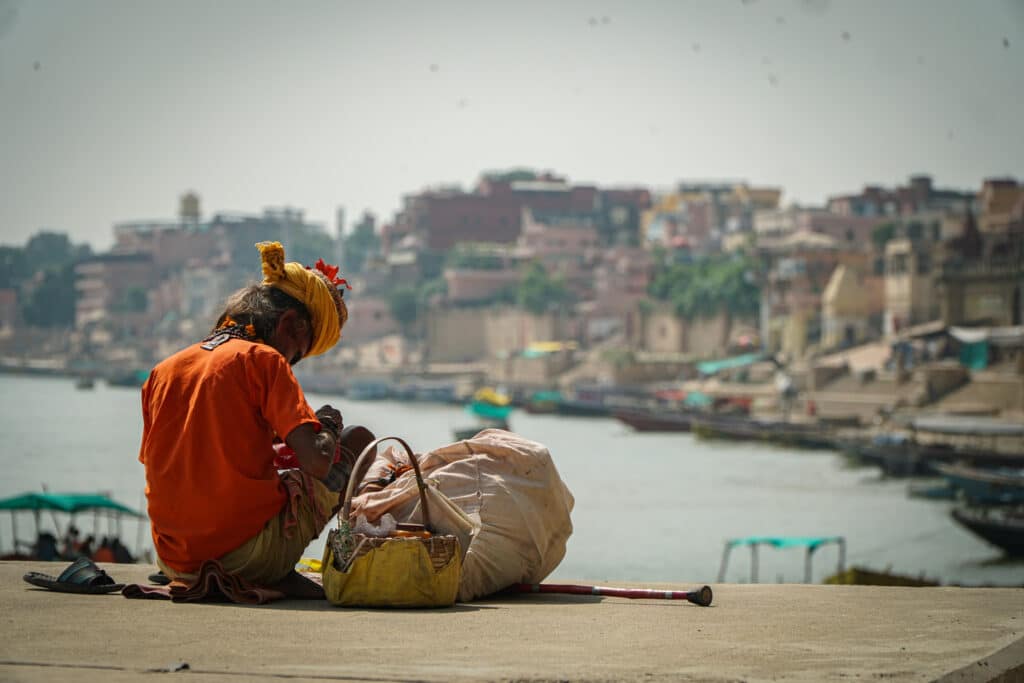
A three-week adventure through North India is an exhilarating experience, weaving through vibrant cities, ancient monuments, and cultural gems. Cam and I have read a lot before planning this trip. With all the pros and cons this is (for us) the best route for a 3 to 4 weeks trip to India. This itinerary promises an unforgettable trip, encompassing the busy streets of Delhi, the mystical charm of Pushkar, the regal aura of Jodhpur and Jaipur, the wildlife spectacle of Ranthambore National Park, the timeless beauty of Agra, and the spiritual magnetism of Varanasi. Join us on this immersive journey, as we unravel the tapestry of North India’s diverse landscapes and rich heritage.
For us, this trip was not a resting vacation! That was an adventure rich in culture and experiences! I can easily say that this is one of the best trip in my life. Enjoy your reading and don’t forget, life is either a daring adventure or nothing at all.
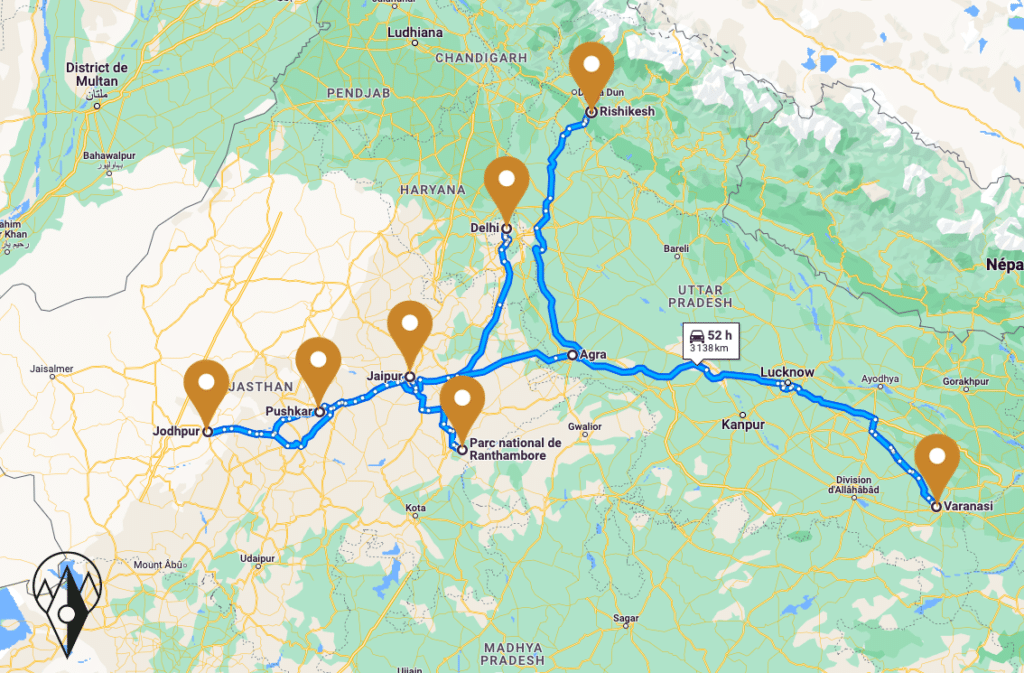
Just before we start, here are few ways you can move between destination for your 3 or 4 weeks trip to India.
TRAINS:
Every major cities in India are really well connected by public transport. According to me, trains are the most convenient way to move around. We were quite surprised how clean the trains are (except the toilets, bring your own toilet paper). In some trains, they clean the floors a few times during the journey. You should know that, when booking a train ticket in India, you have a few options:
Just so you know, it is the same beds (same mattress and same bed comfort) from First Class AC to Third Class AC. Also, Indian railways employees sell food and drinks in the train. You can even get food delivered in the train from outside restaurants.
It can be hard as a foreigner to book train tickets online on the official website. Sometimes you get on waiting lists and your seats are not certain. You can create an account and give it a try on the Indian Railway website. It is a well known difficulty so a lot of hostels and hotels will help you book your trains for you!
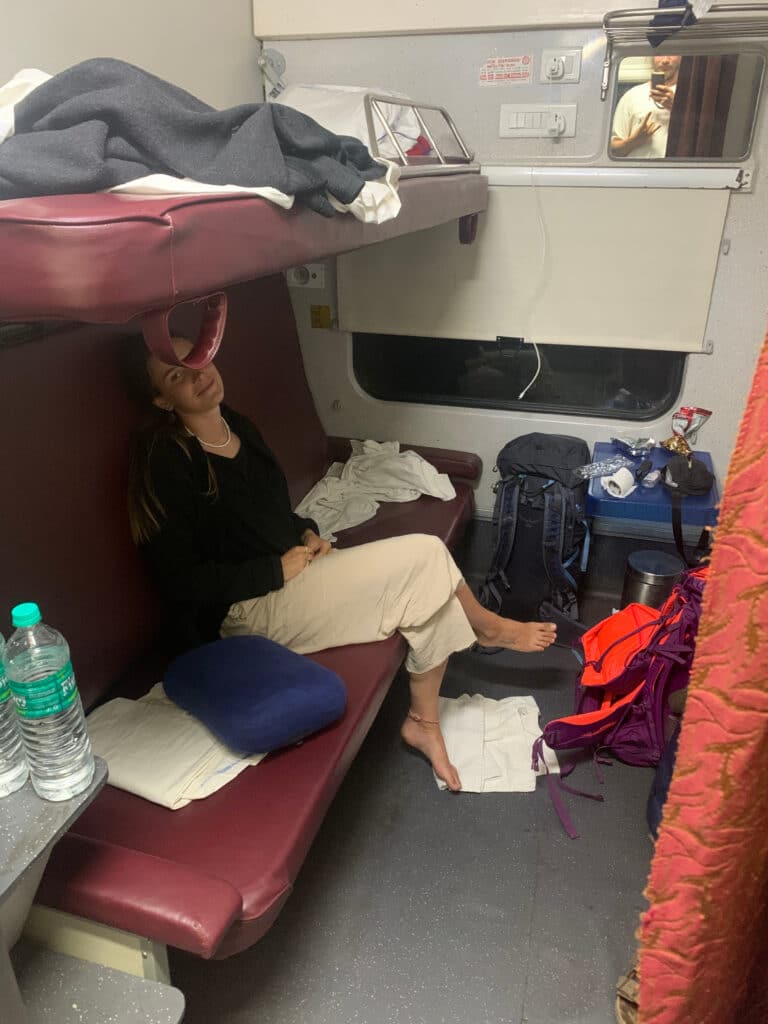
BUS:
The other option for public transport in India is the bus. You can choose between sleeper bus, semi-sleeper bus or seater bus. All of them with AC or not, choose carefully! A good website to book bus tickets in India is Red Bus. The prices of the bus vary between 240 INR to 600 INR (3$ to 6$ USD) depending on the trip. We did Rishikesh to Delhi in a seater bus, booked on Redbus, and it was totally fine.
PRIVATE DRIVER:
One other good option of travelling around India is hiring a private driver. It is indeed a more expensive way to travel but it is the safest, easiest and fastest way to move around. You also have the latitude of stoping and visiting whatever you want. The driver is available 24/7 for any needs or emergency. We heard that most of the drivers expect you to give tips at the end of the journey (more than 50USD).
The famous TUKTUK, of course ! There is between 8 to 10 millions tuktuk driving around in India. You will even get tired of telling them NO when they offer you rides on every street corner. It is important that you bargain your prices before the ride otherwise you will have pricy surprises when you reach your destination. You should know that a lot of driver cannot read so have your Google Map ready in case they don’t know where you want to go. Sometimes, we had to make the driver rings our hotel so the they could tell him how to reach the hotel. I noticed that the electric tuk-tuk are normally cheaper than the gas one.
First things first, ensure that your routine vaccinations, such as measles, mumps, rubella, diphtheria, tetanus, and pertussis, are up-to-date. Consult with a healthcare professional to discuss and receive vaccinations specific to India, such as Hepatitis A and B, typhoid, Japanese encephalitis, and polio.
Psst: I got the dengue in Varanasi and it was awful, i was in bed sleeping for 9 days with fever, headach, pain in the eyes and in all my body. So put that mosquitoes repellent on that skin ! Varanasi is actually an endemic region for japanese encephalitis and dengue.
This itinerary is not a rush and fast travel journey, Cam and I generally like to spend at least 3 nights in every places we visit. Otherwise the transportation gets exhausting, especially in India where more of the cities are hours away from one another. You could spend less time in every city and cover more places, that’s up to you, but here is what we did:
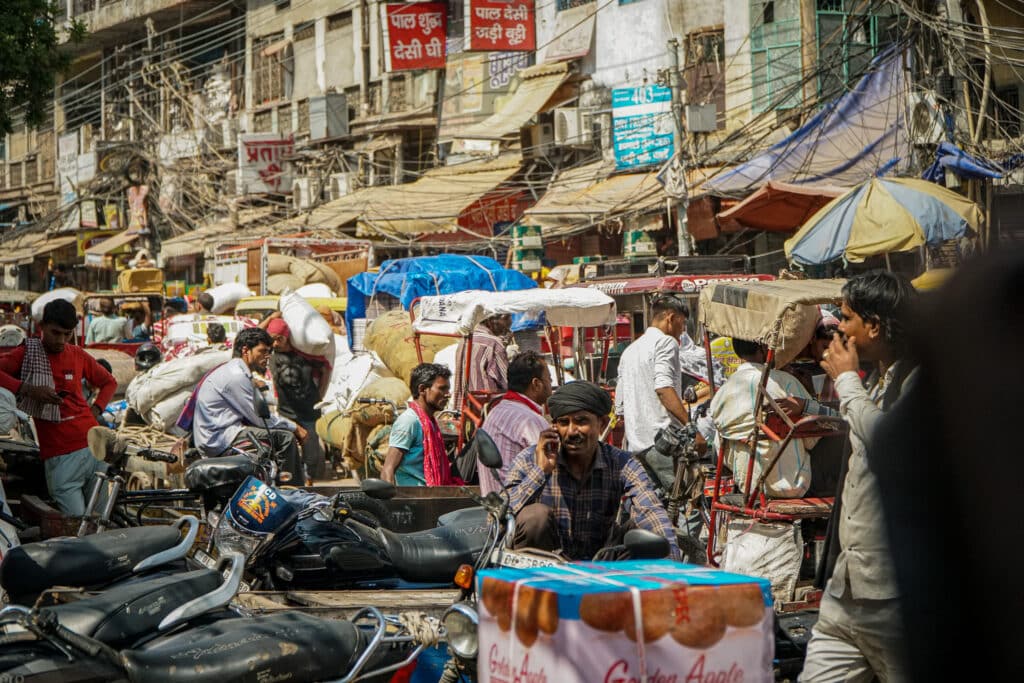
We recommend you to land in Delhi international airport to start your trip. This is gonna be a shock, that is for sure. Your trip to India kicks off in the bustling metropolis where almost 33 millions people live. Begin by immersing yourself in the historical wonders of Old Delhi. Where narrow lanes lead to the imposing Jama Masjid, one of the largest mosques in India and the bustling Chandni Chowk which is the biggest spice market in Asia.
Delhi is India that you see in movies. It is over crowded, polluted and dirty. That is an experience itself, all the smells, the constant honks, the people everywhere, your personal space reduced to non, it is a meaningful adventure, all of your senses are stimulated. We never felt like we were in danger there but be sure you know where to go and where not to go. For me, two days was enough to visit Delhi and its attractions.
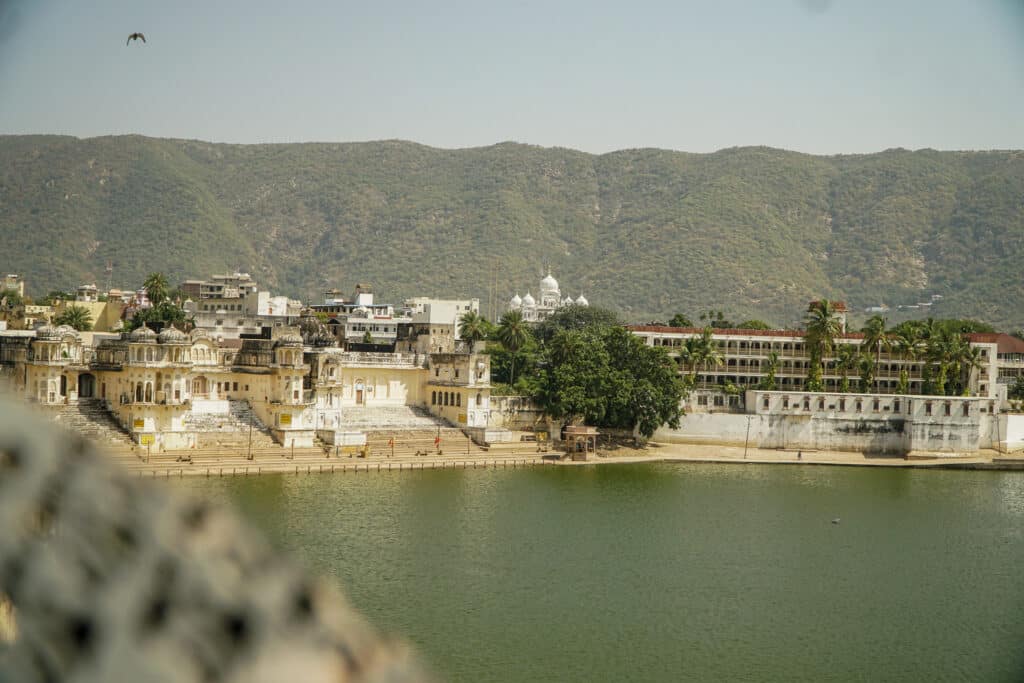
From Delhi you can take a 7 hours trains to Ajmer and then a 30mins tuktuk ride to Pushkar. This famous holy town is well known for its sacred lake and the vibrant Pushkar Camel Fair. Immerse yourself in the spiritual ambiance, exploring the Brahma Temple and witnessing the mesmerizing evening aarti by the ghats.
The Brahma Temple, dedicated to Lord Brahma, is one of the primary attractions in Pushkar. Pilgrims and tourists alike visit this temple to seek blessings and witness the only temple dedicated to the creator of the universe.
The Pushkar Camel Fair, held annually in November, is one of the largest and most famous livestock fairs in the world. It attracts traders, tourists, and locals who come together to witness the spectacle of thousands of camels, horses, and cattle being bought and sold. The fair is also a cultural extravaganza, featuring folk music, dance, camel races, and competitions like the “longest mustache” contest.
Pushkar‘s vibrant markets offer a range of Rajasthani handicrafts, textiles, and jewelry. The narrow lanes are lined with shops selling colorful fabrics, beads, and traditional items, making it a haven for shoppers.
The highlight for me was the Savitri Temple. Perched on a hill, it offers panoramic views of Pushkar and its surroundings. The trek to the temple which is mostly stairs is rewarded with breathtaking vistas, especially during sunrise and sunset. There is also a colony of friendly Gray langur by the temple.
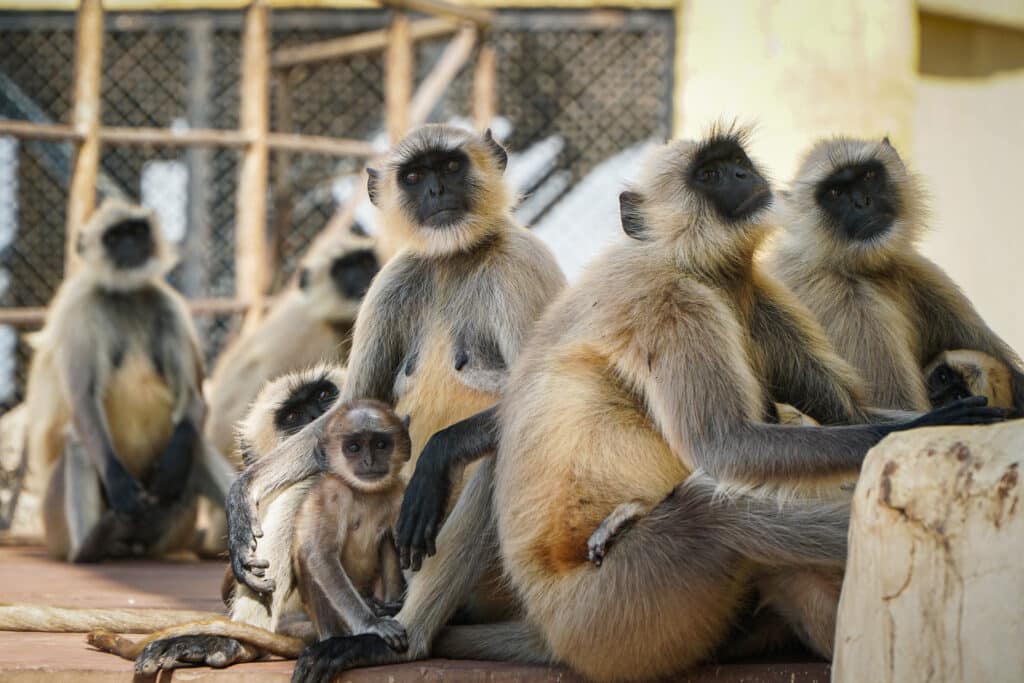
Since it is a holy city, there is no meat or alcool being served in restaurants or markets in the whole city. There is also a famous scam running in Pushkar (Cam and I got caught by this one). You will be walking around the lake and locals will give you free flowers to throw in the lake as a spiritual ritual. They will tell you that there is a festival going on by the lake. Once you will get to the lake, people will approach you to help you with your flowers and do a ceremony with you. You will get sucked into this fake ceremony, they will put things on your forehead and make you say some rituals. Then they will ask you a crazy amount of money. With me, they got really agressive and intense about it. We met some people that had to get to the ATM and take out cash.
Now you know ! 😀
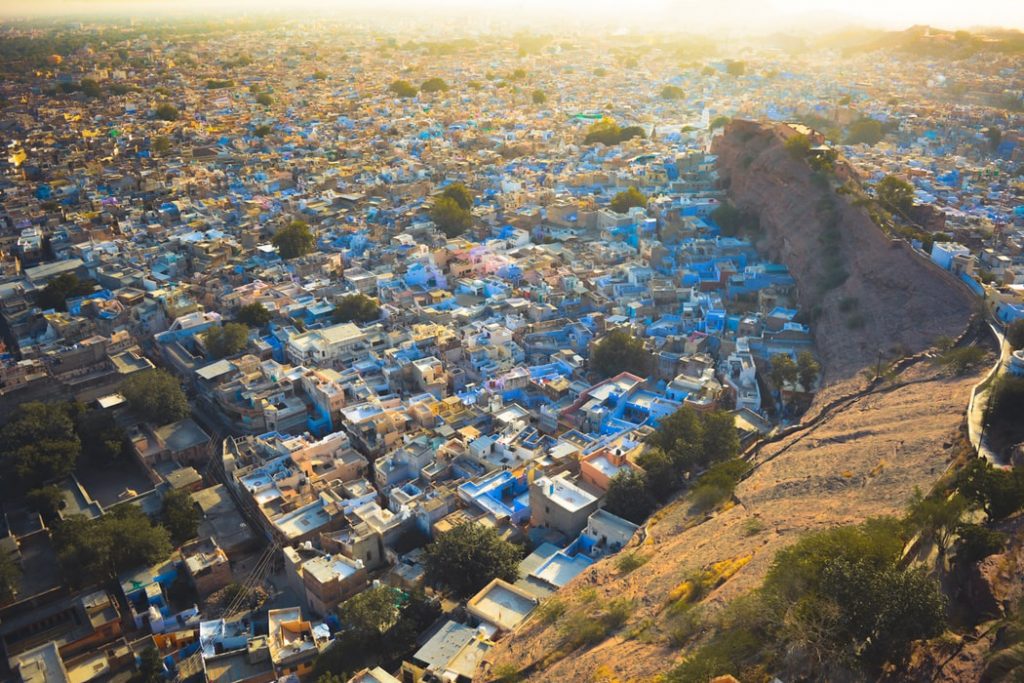
From Ajmer, you take a 4 hours train to Jodhpur, the “Blue City” where the imposing Mehrangarh Fort dominates the skyline. Wander through the narrow lanes of the old town, capturing glimpses of the iconic blue houses. Dive into the city’s royal history at Umaid Bhawan Palace before continuing your India itinerary.
Mehrangarh Fort is one of the largest forts in India. Built on a hill, it offers panoramic views of Jodhpur’s blue-painted houses and the surrounding landscape. The entrance fee is 600 Indian roupies (7$ USD) It offers a breathtaking 360 degree view of the city.
Toorji Ka Jhalra (Toorji’s Step Well) is also an impressive thing to see in the city of Jodhpur. You can see kids playing and jumping in the water
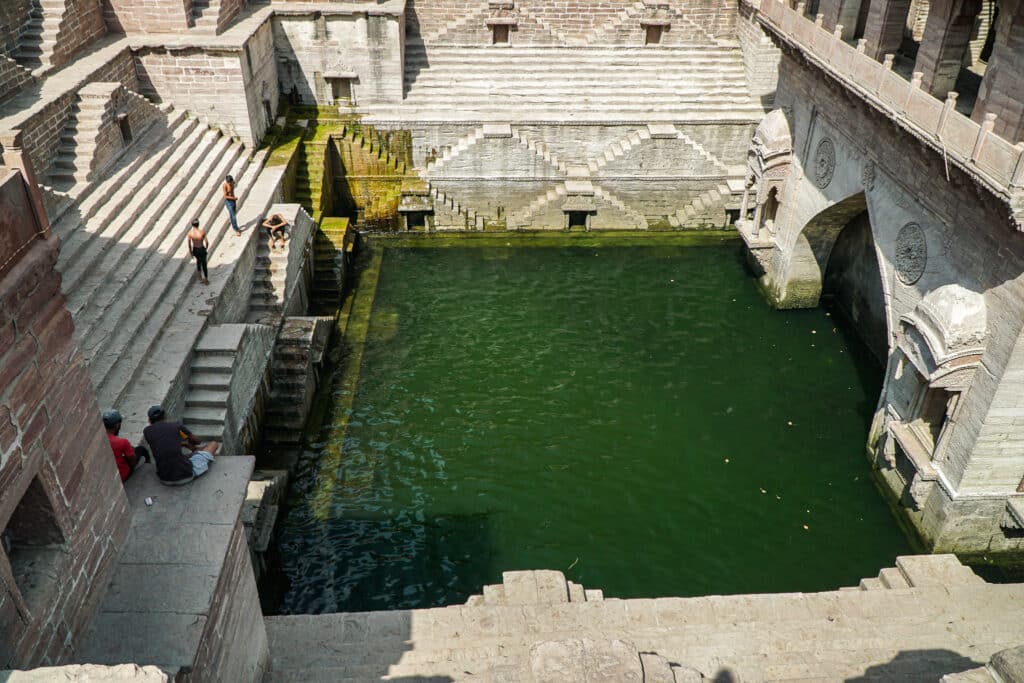
Our highlight of Jodhpur (and maybe of our whole trip to India) was our cooking class with a lady named Rekha. We spent some time with the family in a traditionnal indian house outside the city of Jodhpur. We cooked with her 9 vegetarian dishes including dessert and tea. It was awesome! You can find her here on GetYourguide or Tripadvisor, her husband is a tuktuk driver, he will pick you up at your hostel and drop you off after the class. You can also book directly with her via Whatsapp, you both are gonna save the fees. Here is the number of Rishi, her husband: +91 70141 01634.
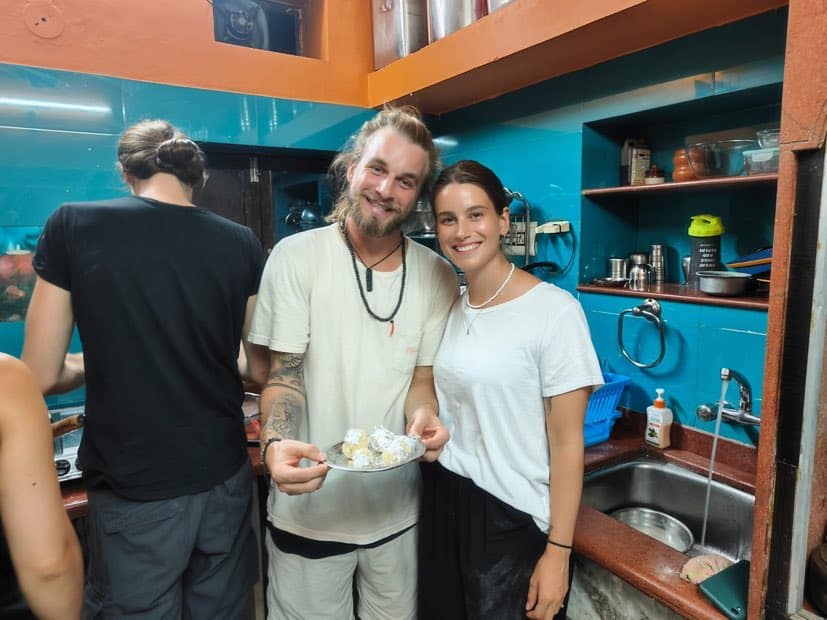
The Clock Tower in the heart of the city is a bustling landmark surrounded by the vibrant Sardar Market. The market is a treasure trove of handicrafts, textiles, spices, and traditional Rajasthani items. It is one of the best place in India to buy spices! Most of the shops will offer you to ship them to you at home. That’s what Cam and I did, 1kg of spices at home and well received.
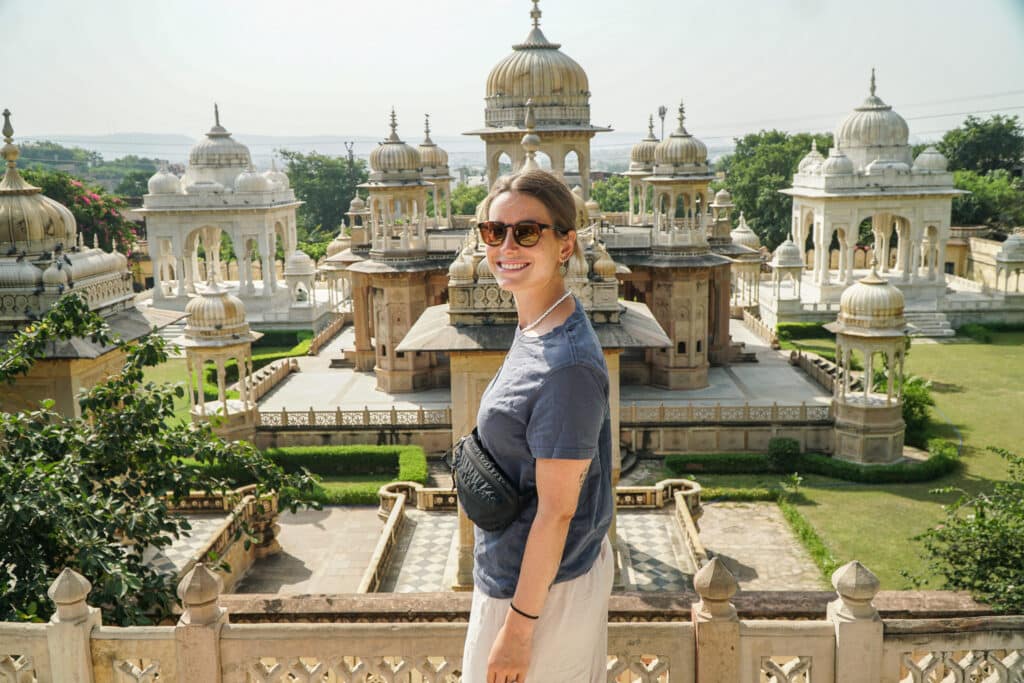
Jaipur, often referred to as the “Pink City,” is the capital and largest city of the Indian state of Rajasthan. Known for its rich history, vibrant culture, and stunning architecture, Jaipur is a popular destination that captivates visitors with its colorful streets, majestic forts, and palaces. Here is the list of beautiful monument you should visit while you are in Jaipur:
Our highlight of Jaipur is definitely the Monkey Temple also known as Galtaji Temple. It is a unique and captivating religious site located amidst the stunning Aravalli Hills. It is home to a colony of macaques and you can even see tiger or leopard in the evening. They come when the site is empty to drink water and hunt monkeys. The entrance fee is about 300 Indian roupies (3,60$USD) per person.
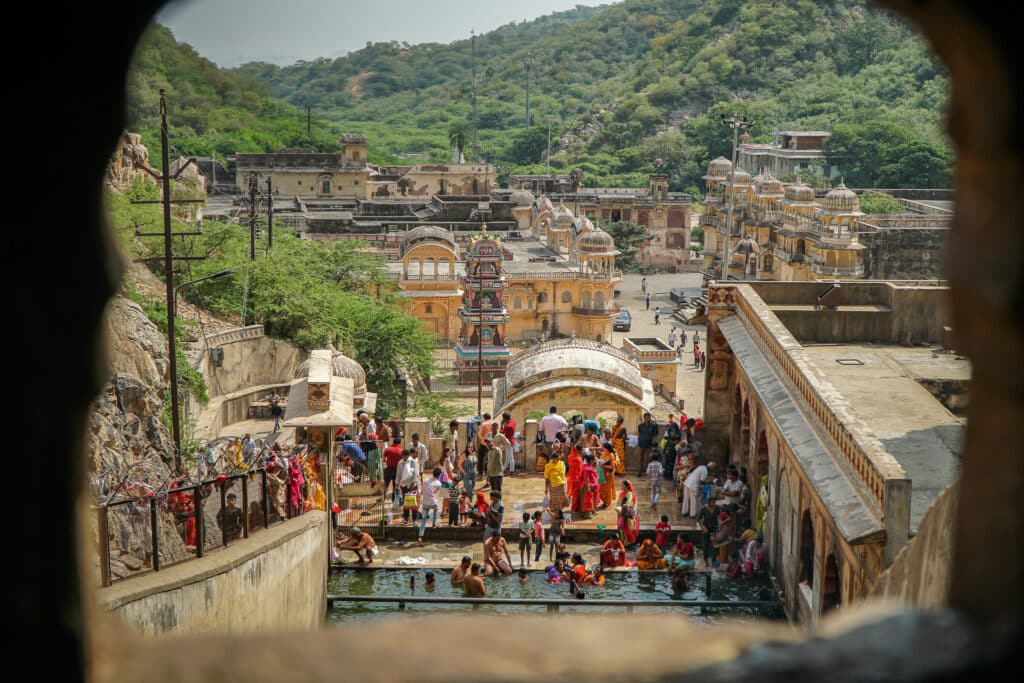
India is full of sneaky scams! In 3 weeks ,it is almost impossible that you won’t get caught in one of them. Here is an other warning about a scam in Monkey Temple. At the entrance there are kids waiting for tourist. They will tell you that the monkeys are dangerous and attack people sometimes so it is safer to go with them. They say you will be protected because the monkeys know the kids. That’s a lie, the monkeys don’t come to you in that temple. We didn’t feel like they were dangerous. Thousand of tourist go there everyday and we were actually the only one with a guide.
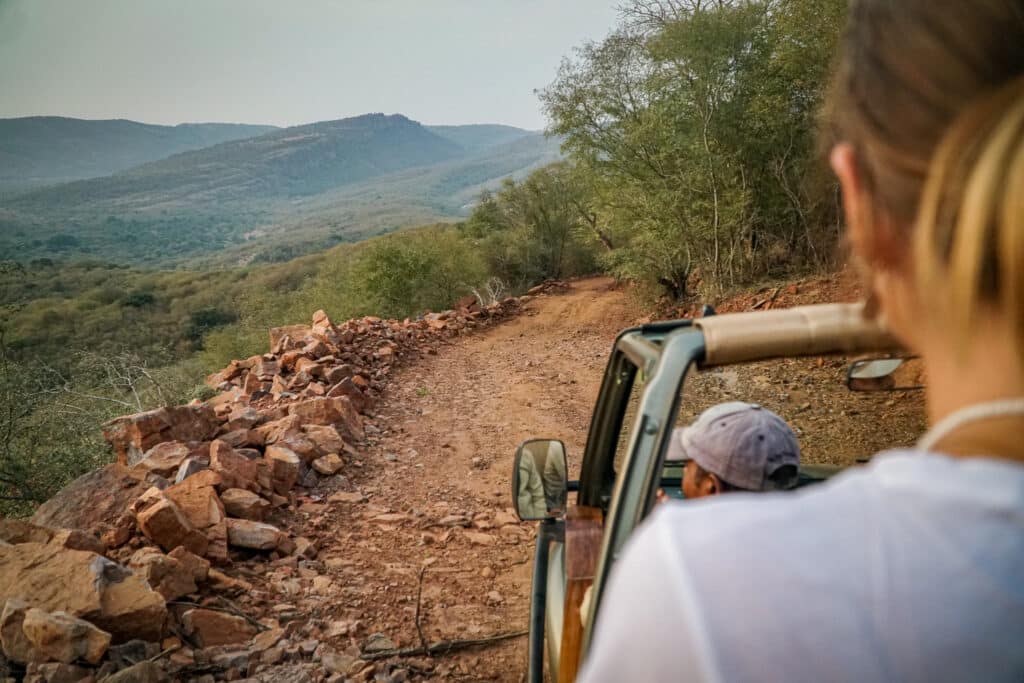
The adventure takes a wild turn as you head to Ranthambore National Park, a haven for wildlife enthusiasts. Embark on a safari to witness the majestic Bengal tigers, leopards, and a myriad of other fauna amidst the scenic landscapes. Ranthambore promises a unique blend of nature and adventure, making it a pivotal point in your India itinerary.
You can do 2 safaris per day. One at 6 a.m. and a second at 2 p.m. There are 10 zones in the park and the choice of zones is drawn randomly in the morning. The chances of seeing a tiger are not guaranteed. Both the winter (October – March) and summer (May-June) seasons are ideal for tiger sighting in Ranthambore. Unfortunately, we didn’t see any but the experience was awesome anyway.
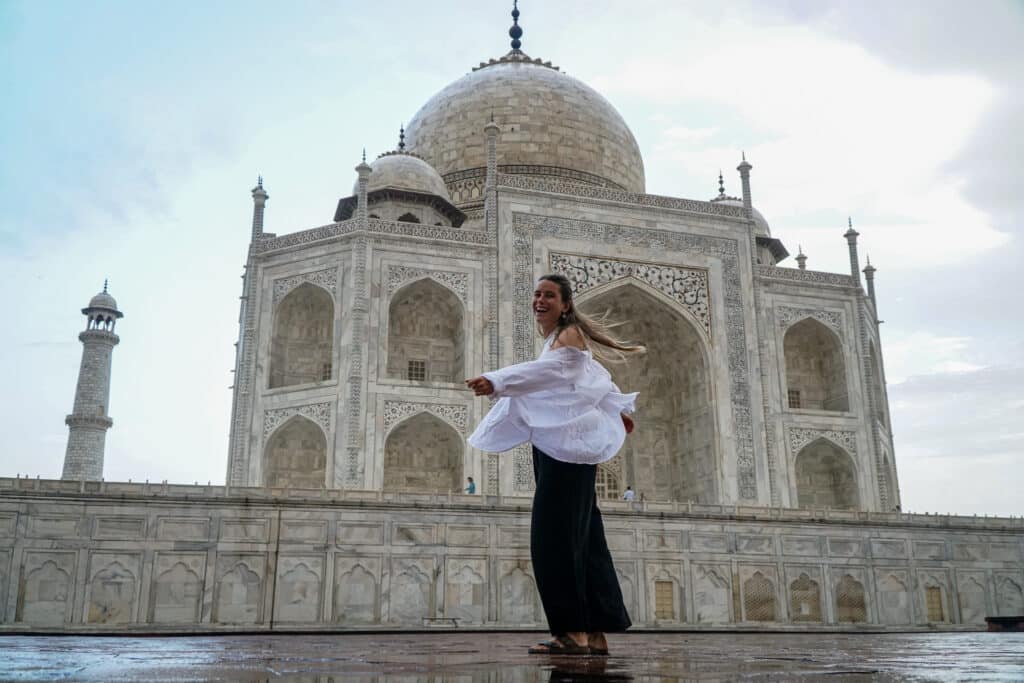
Next on the map is the city of Agra, home to the iconic Taj Mahal. Marvel at the timeless beauty of this architectural masterpiece, explore the Agra Fort, and stroll through the Mehtab Bagh for a breathtaking view of the Taj across the Yamuna River.
The Taj Mahal is the crown jewel of Agra and one of the most recognized symbols of India. It was built by the Mughal Emperor Shah Jahan in memory of his beloved wife Mumtaz Mahal.
The Agra Fort, also known as the Red Fort of Agra, is a massive fortress built by Emperor Akbar. It served as the main residence of the Mughal emperors until the capital was shifted to Delhi.
If you want to avoid the crowds, it’s better to go really early in the morning. Doors open at 6am and we decided to get there around 5.30am and there was already 50 people queuing. We had an amazing experience there. Around 9am, it got pretty crowded and hard to take photos. One of our friend went there at 4.50am and he was the first one. Try not to bring any bags because they screen it, then people overtake you on the queue.
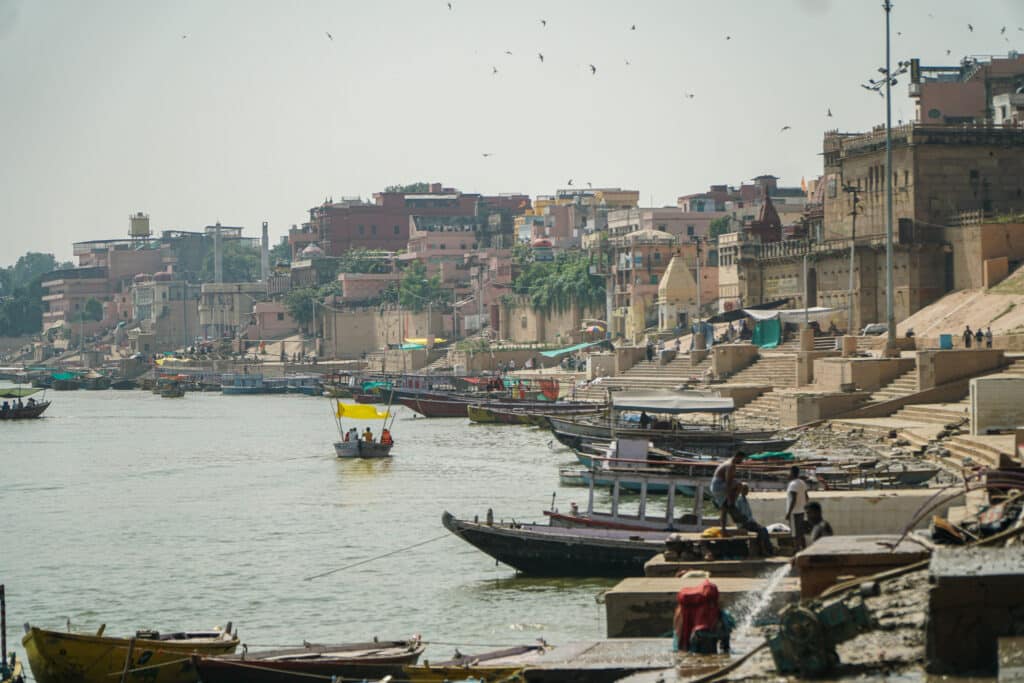
Beckons with spiritual resonance along the banks of the sacred Ganges River. Attend the mesmerizing Ganga Aarti at Dashashwamedh Ghat, take a boat ride along the ghats, and explore the narrow alleys of the ancient city. Varanasi encapsulates the essence of spiritual India, providing a fitting conclusion to your three-week journey.
Varanasi is renowned for its ghats along the Ganges River, and among these, the two prominent ghats for cremation are Manikarnika Ghat and Harishchandra Ghat. These ghats hold immense spiritual significance and are central to the city’s cremation rituals.
Cremation are guided by ancient traditions and beliefs rooted in the cycle of life, death, and rebirth. Be prepared, you will see a lot of dead bodies around those Ghats. It is their funerals and there is a big ceremony around it. You will definitely not feel at home.
Boat tours on the Ganges are really inexpensive and give you another perspective of the city and the atmosphere.
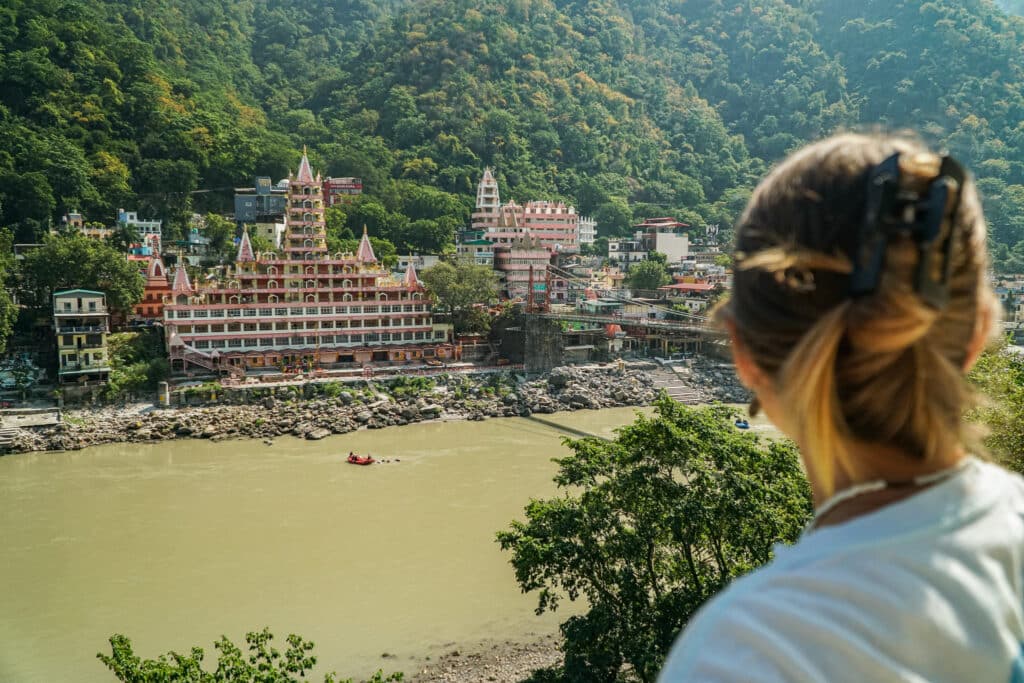
Rishikesh, often referred to as the “Yoga Capital of the World,” is a spiritual and adventure hub nestled in the foothills of the Himalayas in the northern Indian state of Uttarakhand. Positioned along the banks of the sacred Ganges River, Rishikesh is not only known for its religious significance but also for its tranquil environment, yoga and meditation centers, and outdoor adventure opportunities.
Rishikesh is globally recognized as a hub for yoga and meditation. The town is home to numerous ashrams and yoga schools offering courses for practitioners of all levels. You can book a one week retreat of Yoga and meditation or a 200-300 hours course to become a yoga teacher.
Annually, Rishikesh hosts the International Yoga Festival, attracting yoga enthusiasts, practitioners, and spiritual seekers from around the world.
The Ganges River offers exciting opportunities for white-water rafting. Adventure enthusiasts can experience various grades of rapids, making Rishikesh a popular destination for rafting. The surrounding Himalayan foothills provide excellent trekking opportunities. Trails lead to scenic spots like Neelkanth Mahadev Temple and Kunjapuri Devi Temple.
As your 3 to 4 weeks trip to India concludes, you’ll carry memories of diverse landscapes, rich history, and cultural splendor. From the bustling streets of Delhi to the tranquil ghats of Varanasi, this North India itinerary is a tapestry woven with the threads of adventure, spirituality, and discovery. The journey leaves an indelible mark, inviting you to revisit the vibrant mosaic that is North India.
Find all the Best Things to do in India in our attractions page
Sam & Cam

What Travel Vaccines Do I Need as a Canadian Traveler? Traveling is life’s greatest joys! However, exploring the world can sometimes expose you to health
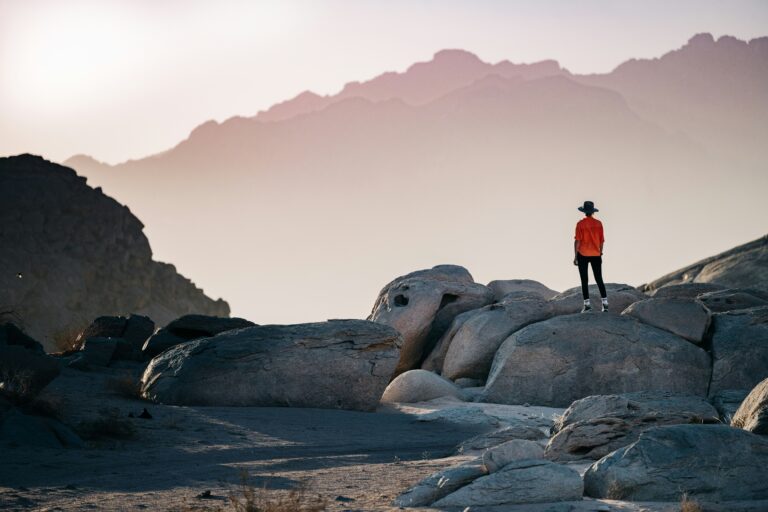
Those are 2 questions that we frequently have In the travelling world. In today’s digital age, it’s easy to assume that booking a trip online

Which Travel Credit Card is the Best for Your Adventures? Traveling opens doors to unforgettable experiences. A good travel credit card can make your journeys
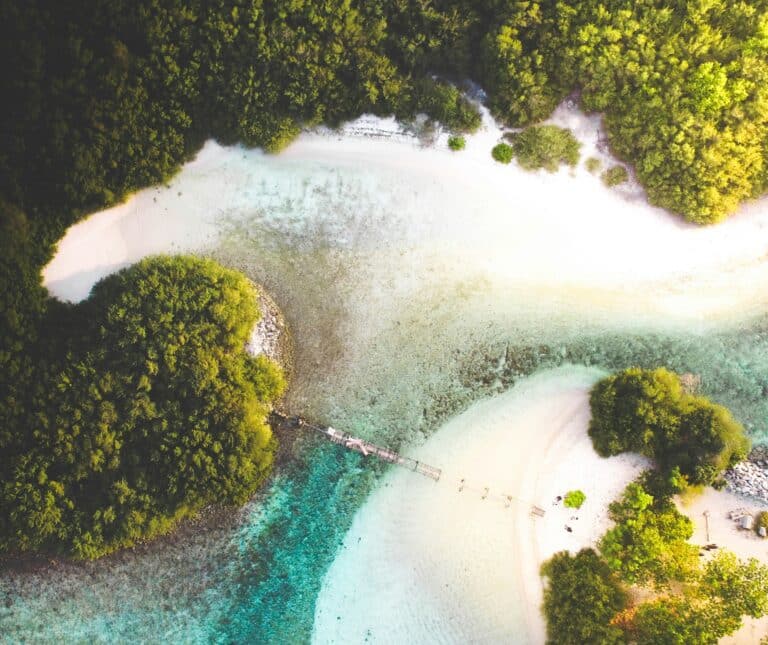
The Maldives, a tropical heaven in the heart of the Indian Ocean, is renowned for its pristine white-sand beaches, crystal-clear turquoise waters, and vibrant coral

Think you know all about travel? Think again! Travel comes with plenty of assumptions, whether it’s about backpacking, all-inclusive resorts, or solo trips. From believing

Sri Lanka has become a popular destination for surfers of all levels, offering a diverse range of surf breaks along its coastline If you’re an
A community based on sharing tips and experiences on the different destinations of the world.